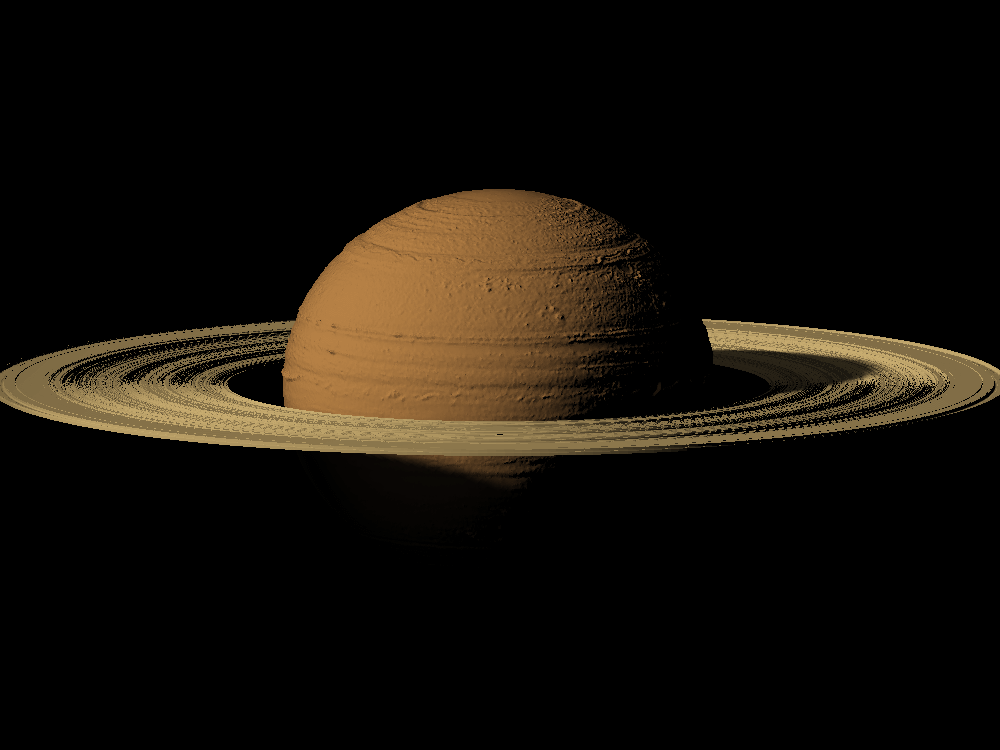
Saturn scaled one in 500 million
prusaprinters
<p>Originally published here: <a href="https://www.thingiverse.com/thing:3930295">Saturn scaled one in 500 million by tato_713 - Thingiverse</a></p><p>Everyone's favourite planet. This model was made using MATLAB R2016a on a global map of the planet made by Bjorn Jonsson, with the contrast enhanced, the exact same method I've used with <a href="https://www.thingiverse.com/thing:3928031">Jupiter</a> . The rings were mare using a image of a section of the ring, projecting them in cylindrical coordinates.</p><p>The file's names explained: <i>name_1_x_10_y.stl</i> is 1 : x* 10y. So _1_6_10_7 is 1:600000000 or one in 60 million. </p><h3>Saturn</h3><p>Saturn is the second largest planet on the Solar System, the planet with the brighter ring system by far, rivalling with the reflection of the planet. It has the most pronounced polar flattening of all the Solar system planets, nearly 10% (<a href="https://www.thingiverse.com/thing:3612782">Earth</a>'s one is 0.3%), after its fast rotation (in ten hours). Jupiter spins a little faster but it is more massive than Saturn, so it flattening is lower (6%). The rings of Saturn are composed of tiny particles of ice, from micrometers to meters in size, that forms a continuos disk with different densities along its radius, with the presence of moonless embebed in the ring. Planet's rings are stable thanks to the gravitational influence of the planet, and the presence of shepherd moons, like <a href="https://www.prusaprinters.org/prints/57314-prometheus-and-pandora-scaled-one-in-two-million">Prometheus and Pandora</a>, that prevents the accretion of the disk material into a denser moon. Saturn is also known for having several kinds of moons, like the planet-sized moon <a href="https://www.thingiverse.com/thing:3501867">Titan</a>, which even has an atmosphere; medium size icy moons, like <a href="https://www.thingiverse.com/thing:3368027">Mimas</a>, <a href="https://www.thingiverse.com/thing:3367575">Enceladus</a>, <a href="https://www.thingiverse.com/thing:3392266">Tethys</a>, <a href="https://www.thingiverse.com/thing:3394531">Dione</a>, <a href="https://www.thingiverse.com/thing:3351179">Rhea</a> and <a href="https://www.thingiverse.com/thing:3323299">Iapetus</a>; irregular moons, like <a href="https://www.thingiverse.com/thing:3406345">Phoebe</a>; a moon with chaotic rotation: <a href="https://www.thingiverse.com/thing:3419489">Hyperion</a>; horseshoe orbit moons: <a href="https://www.thingiverse.com/thing:3563639">Janus and Epimetheus</a>; and trojan moons, like <a href="https://www.thingiverse.com/thing:3907487">Telesto and Calypso</a>, which orbits along with Tethys, and <a href="https://www.thingiverse.com/thing:3907501">Helene</a> and Polydeuces, which orbits along with Dione. Saturn is uncommon among gas giants at not having trojan asteroids. However there are minor planets whose orbits cross that of the outer planets, they are known as centaurs (like Chiron and <a href="https://www.thingiverse.com/thing:3608424">Chariklo</a>).</p><ul><li><strong>Type:</strong> Planet. Gas giant. </li><li><strong>Orbit:</strong> Sun. </li><li><strong>Orbital period:</strong> 29.4571 yr.</li><li><strong>Composition:</strong> Hydrogen, helium atmosphere; metallic hydrogen mantle, rocky core.</li><li><strong>Density:</strong> 0.687 g/cm3. </li><li><strong>Dimensions:</strong> 120536 km × 108728 km </li><li><strong>Model scale:</strong> 1:5x108 (24cm) 1:1x109 (12cm)</li></ul><h4>References</h4><ul><li><a href="https://www.mathworks.com/matlabcentral/fileexchange/4512-surf2stl">Surf to STL function for MATLAB </a></li></ul><h4>Other astronomical objects</h4><p><a href="https://www.prusaprinters.org/social/120859-tato_713/collections/49826">Inner Solar System</a></p><p><a href="https://www.prusaprinters.org/social/120859-tato_713/collections/49832">Artificial</a></p><p><a href="https://www.prusaprinters.org/social/120859-tato_713/collections/49820">Near Earth Asteroids</a></p><p><a href="https://www.prusaprinters.org/social/120859-tato_713/collections/49291">Main Belt Asteroids</a></p><p><a href="https://www.prusaprinters.org/social/120859-tato_713/collections/49829">Jovian System</a></p><p><a href="https://www.prusaprinters.org/social/120859-tato_713/collections/49828">Saturn System</a></p><p><a href="https://www.prusaprinters.org/social/120859-tato_713/collections/49830">Uranian System</a></p><p><a href="https://www.prusaprinters.org/social/120859-tato_713/collections/49345">Neptunian System</a></p><p><a href="https://www.prusaprinters.org/social/120859-tato_713/collections/49827">Centaurs</a></p><p><a href="https://www.prusaprinters.org/social/120859-tato_713/collections/49833">Comets</a></p><p><a href="https://www.prusaprinters.org/social/120859-tato_713/collections/49341">Trans Neptunian Objects</a></p><p><a href="https://www.prusaprinters.org/social/120859-tato_713/collections/49824">Extrasolar Objects</a></p><p><a href="https://www.prusaprinters.org/social/120859-tato_713/collections/49837">Sky Maps</a></p><p><a href="https://www.prusaprinters.org/social/120859-tato_713/collections/49831">Ancient</a></p><p><a href="https://www.prusaprinters.org/social/120859-tato_713/collections/49822">Speculative</a></p><p><a href="https://www.prusaprinters.org/social/120859-tato_713/collections/49821">Science Fiction</a></p>
With this file you will be able to print Saturn scaled one in 500 million with your 3D printer. Click on the button and save the file on your computer to work, edit or customize your design. You can also find more 3D designs for printers on Saturn scaled one in 500 million.
